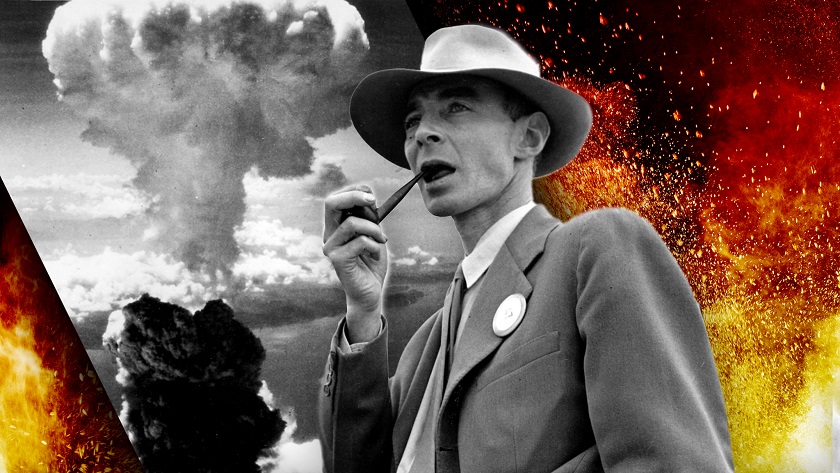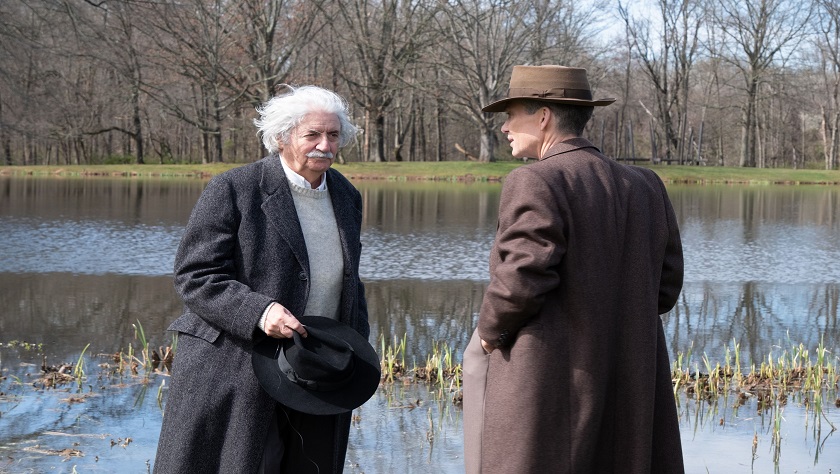Iran Press/ America: American officials, from the president of the United States during World War II, Harry Truman, who ordered the atomic bombing of these two Japanese cities, and the subsequent officials in the White House, always had a familiar justification for this horrible event: "We had to do this to establish peace."
However, the most important part in the formation of the human and destructive disaster of the atomic bombing of two Japanese cities in World War II is the story of the creation of the atomic bomb.

In order not to fall behind in the competition with Nazi Germany and the Soviet Union, American officials planned and spent a lot of money to build an atomic bomb.
Julius Robert Oppenheimer, the famous American physicist, was the most important person who, of course, with the direct support of the American government, advanced the project of making the atomic bomb or the "Manhattan" project. The movie "Oppenheimer" is the story of the first test of the atomic bomb and the life and spirit of its maker, and the project that this famous scientist carried out with the cooperation of another group of physicists.
Hollywood, in this summer of 2023, released the 3-hour movie Oppenheimer directed by Christopher Nolan, the famous Hollywood director, which was produced and distributed by the "Universal" film company, in the United States and around the world. The cost of making "Oppenheimer" is estimated to be around 100 million dollars, and with extensive advertising, the manufacturing company must have sales of around 400 million dollars to make it profitable.

Robert Oppenheimer, the infamous Los Alamos evil
Professor Oppenheimer, in a project led by American General Leslie Groves under the supervision of the Atomic Energy Commission (AEC) of United States, gets a mission to build the first atomic bomb. Reports were published in the American and European press during the Second World War, showing that German scientists succeeded in splitting the nucleus of an atom, which was the first important step in making an atomic bomb.
Albert Einstein, a famous physicist, and his colleague, Leo Szilard, wrote a letter to Franklin Roosevelt, the President of the United States during the Second World War, and warned about Adolf Hitler and Nazi Germany gaining atomic power, and raised the possibility of building an atomic bomb in the United States.
This project was known as Manhattan and its management was entrusted to Oppenheimer. This American physicist considered a desert area in Los Alamos, New Mexico to advance his project, and the project began. The Manhattan Project started around 1942 and continued until shortly after the atomic bombings of Hiroshima and Nagasaki.
About 130,000 people worked in Oppenheimer's atomic city, including military personnel, scientists, and office workers. The most important part of Oppenheimer's mission in the atomic city that he had founded himself was the first test of the atomic bomb or the so-called "Trinity". A simulated atomic explosion was carried out by placing a sample bomb on top of a high platform far from the ground on July 16, 1945 in the Jornada del Muerto desert.
 In 1945, a war correspondent stands in the ruins of Hiroshima, weeks after an atomic bomb leveled the Japanese city.
In 1945, a war correspondent stands in the ruins of Hiroshima, weeks after an atomic bomb leveled the Japanese city.
Unlocking the keys of the black box with the knowledge of physicists
Oppenheimer, along with the specialized team of scientists and intellectuals who accompanied him to manage the Manhattan Project, had to think about important questions about the possible consequences of the atomic explosion. In the process of scientific experiments, one of the mathematicians of the Oppenheimer group pointed out that even an experimental atomic explosion will release unimaginable energy into space, which may lead to the sky catching fire and destroying the earth.
Einstein, however, did not give a clear answer to Oppenheimer's question, and when he found out that the famous physicist Hans Albrecht Bethe was working with Oppenheimer, he assured that the Bethe's calculations were accurate and could estimate the possible risk assessment. Although Bethe had accurate calculations, his final answer was that the probability of a devastating explosion for the planet would be close to zero (not absolute zero), so he assessed the probability as very weak, but despite this prediction, the probability of a terrible explosive risk is small.
The testing of the atomic bomb also created conditions for physicists to pursue the creation of weapons more destructive than the atomic bomb, such as the hydrogen bomb. Edward Teller, a Hungarian scientist who immigrated to US after the First World War, was one of the people who collaborated with Oppenheimer in the Manhattan Project.
Teller's idea was to make a weapon far more dangerous than the atomic bomb, and he tried to realize his idea, while Oppenheimer was strongly against this issue. Finally, in the years after the Second World War, Edward Teller implemented his project to build a terrible and destructive hydrogen bomb, which made one of his contemporaries wish that Teller had never been born. Another part of the influential role of science, but the knowledge that was actually used by the politicians of the White House for their purposes during World War II, was quantum physics and its role in military projects and goals.
Oppenheimer was one of the most famous physicists of the 20th century and a prominent name in quantum physics. The beginning and development of this science in America started with the holding of Oppenheimer's classes in American universities. Quantum physics studies physics at very small dimensions (even smaller than atoms). But, scientists of this branch of physics also theorize about macroscopic systems such as galaxies and stars. The study of the action and quality of atoms is also discussed in this branch of science.

The life story of Oppenheimer, the destroyer of worlds
The Oppenheimer movie directed by Christopher Nolan is based on the book American Prometheus which two American writers Kai Bird and Martin Sherwin started writing in the 1980s and after almost 25 years and interviews with hundreds of people it was published.
The story of the movie begins with Oppenheimer's youth and studies, as a young physicist, he goes to many famous scientists to learn physics from them.
Young Oppenheimer, played by Cillian Murphy, like many educated people, had leftist and communist tendencies, and for this reason, even when he started planning the Manhattan Project, the security authorities and the American Federal Police looked at him as a suspect. At the beginning of the movie, Oppenheimer somehow predicts his fate and uses a phrase from one of the Hindu books and says: "I will die now, the destroyer of worlds." Levi Strauss, the wealthy American Jewish entrepreneur who is played in the movie by "Robert Downey Jr.", heard Oppenheimer's reputation as a famous scientist and invited him to work in a scientific center. Strauss is annoyed by Robert's pride and arrogant behavior, and this always exacerbates the rift between the two.
The story of the film continues with Oppenheimer's scientific successes in America and the publication of his scientific articles in various journals, but the security institutions do not trust him and observe Oppenheimer's activities as a subversive element and a supporter of the Soviet Union. This is in the circumstances that the American general "Leslie Groves" played by "Matt Damon" in the movie is in charge of the Manhattan Project.
Oppenheimer has a large budget to advance his project so that the construction of the first atomic bomb for the United States can proceed as quickly as possible surpassing those of Germany and the Soviet Union. Oppenheimer's problems are more than satisfying scientists and scientific elites or even ordinary people to live in the atomic city of Los Alamos, and on the other hand, worrying about the result of an atomic test that could even lead to the destruction of the planet.
 The Atomic Bombing of Hiroshima
The Atomic Bombing of Hiroshima
The plot of the film, and the description of the events of the story is in the committee that the American Congress formed to investigate Oppenheimer. The famous American Physicist has to answer various questions in this committee, which was formed in the years after World War II, including his participation in meetings of leftist groups in America, and another part that Oppenheimer is not very willing to say, the disclosure of his immoral relationships.
Oppenheimer must also be held responsible for the disclosure of atomic secrets and the fact that one of the British scientists who visited Los Alamos provided information about the Manhattan Project to the Soviet Union. Oppenheimer and even his wife "Katie" played by "Emily Blunt", who was also a communist activist, have to participate in the congressional investigation committee and tell the story of their life's failures and even its details. Oppenheimer and his wife find out that Strauss, his old friend, has decided to take revenge on them because he himself is trying to reach the position of the ministry, thus he wants to sacrifice Oppenheimer.
The results of the congressional committee meetings are not satisfactory for Oppenheimer and his security clearance is revoked while his competence is questioned. Strauss did not get what he wanted and Congress did not approve his qualification for the ministry post.
 Einstein and Oppenheimer
Einstein and Oppenheimer
In the film, three different sequences may represent Oppenheimer's mood and destiny. At the beginning of the movie, when he calls himself the "destroyer of worlds", it represents his unceasing efforts to make the atomic bomb, but it ended in nothing but infamy. Another sequence, almost at the end of the film, he meets with the President of the United States, Harry Truman, but this meeting is tense, where Oppenheimer tells Truman, "Mr. President, I feel that my hands are stained with blood."
Another sequence at the end of the film is the fateful meeting of Einstein and Oppenheimer, when he expresses his concern to the famous scientist that the creation of this atomic bomb will create a terrible chain for the world. Perhaps Oppenheimer's fate is the sentence that he himself told as a young physicist in the definition of black holes, "that stars, if they have a long life, will cool down from the galaxy and finally die."

Oppenheimer; Prometheus in Fire
Torment of conscience and an unforgettable crime, Christopher Nolan's three-hour narrative about Oppenheimer's life, portrays different angles of his life, but the movie's story has an absent and intentionally forgotten scene.
In the story of the film, Oppenheimer's long meetings with the members of US Congress are narrated many times, and also a significant time of the film is devoted to the story of the first atomic test. But, on the other hand, not even a single sequence or image of the atomic bombing of Japan is portrayed, nor the human disaster created after it. The story of Nolan's film is narrated in a direction where its main focus is to justify the use of nuclear weapons by the United States.
For this reason, the director and the producers of the film have not included any image or view of the atomic bombing of Japan in the film, and it is mentioned in the story only via the reports that have been published in the newspapers. Another subplot in the film's story, which is also mentioned in a limited way, is the arms race that develops after the first atomic test between the United States and the Soviet Union. Alao, a more terrifying story than the creation of an atomic bomb is the creation of a much more dangerous and destructive weapon, the "hydrogen bomb", which is many times more destructive than atomic weapons used in Japan.
Oppenheimer, in a way, was against this process and tried not to enter this terrible game, but the consequences for him were his removal from government positions. Although during the John F. Kennedy era, he was invited to the White House and honored, but the story of his response to the Congress caused an irreparable blow to his prestige and scientific status.
In Greek mythology, Prometheus was the protector of fire, who was punished by "Zeus" for neglecting to maintain this element and thus he was imprisoned. The story of Oppenheimer's life also shows a confrontation between the power holders in the Congress and the White House with a scientist who was abused for political purposes and paid its price with his notoriety in human history.
Ashkan Salehian

